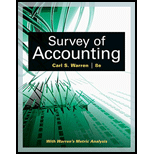
(a)
Introduction:
Accounting ratios are used to evaluate the financial performance of the business organisation.
Time interest earned TIE :
It is a matric used to measure a company's ability to meet debit obligation it can be calculated using following formula:
The time interest earned.
Answer to Problem 9.20E
Solvency analysis using time interest earned suggests that the company is in good solvency position as time interest earned shows it has adequate earning to pay debt obligationswhich is 8.75 times and shareholders ratios suggest enough earnings for shareholders.
Explanation of Solution
| Ratios | ||
| a | Time interest earned | |
(b)
Concept Introduction:
Time preferred dividends earned: it measures company's ability to pay preferred dividends in it also known as dividends coverage it can be calculated using following formula:
To calculate:
Time preferred dividends earned
Answer to Problem 9.20E
Solvency analysis using time preferential dividends earned paid suggests that the company does not have earning to pay preferential dividends obligations which is 0.05 times.
Explanation of Solution
| Ratios | ||
| b | Time preferred dividends earned | |
(c)
Concept Introduction:
Earnings per share: show how many dollars of net income is earned by common stockholder, it can be calculated using following formula.
To calculate:
The profit earned on each issued share using earning per share.
Answer to Problem 9.20E
Profitability analysis using earning per share suggests that the profitability position of the company is satisfactory.
Explanation of Solution
| Ratios | ||
| c | Earnings per share | |
(d)
Concept Introduction:
Price earnings ratio P/E ratio: it indicates the amount an investor can expect to invest in a company in order to receive one dollar of company's earnings.
Expected price of share based on earning using price earnings ratio.
Answer to Problem 9.20E
Profitability analysis using price earning suggests that the profitability position and positive future performance.
Explanation of Solution
| Ratios | ||
| d | Price earnings ratio | |
(e)
Concept Introduction:Dividends per share:
It is the sum of ordinary dividends declared by the company.
Dividends per share of common stock.
Answer to Problem 9.20E
Profitability analysis using dividends per share suggests that the profitability position of the company is satisfactory and can declare dividends at the rate of 0.03.
Explanation of Solution
| Ratios | ||
| e | Dividends per share | |
(f)
Concept Introduction:
Dividends yield: is an estimation of dividend only
To calculate:
Annual dividends received per share.
Answer to Problem 9.20E
Profitability analysis using dividends yield suggests that the profitability position of the company is satisfactory, and SHI Inc. annual value of dividends received were 0.04.
Explanation of Solution
| Ratios | ||
| f | Dividends yield | |
Want to see more full solutions like this?
Chapter 9 Solutions
Survey of Accounting (Accounting I)
- Please provide the accurate solution to this financial accounting question using valid calculations.arrow_forwardLast year the return on total assets in Jupiter Manufacturing was 15%. The total assets were 4.2 million at the beginning of the year and 4.6 million at the end of the year. The tax rate was 22%, and sales were $7.5 million. What was the net income for the year?arrow_forwardI need help with this financial accounting problem using proper accounting guidelines.arrow_forward
- I need assistance with this general accounting question using appropriate principles.arrow_forwardCan you explain the correct methodology to solve this financial accounting problem?arrow_forwardPlease provide the accurate answer to this general accounting problem using valid techniques.arrow_forward
- The revaluation model for PPE requires? 1. Revaluations at regular intervals with sufficient frequency 2. Annual revaluations only 3. One-time revaluation at management's discretion 4. Revaluation only when asset is impaired Helparrow_forwardCan you help me solve this general accounting problem with the correct methodology?arrow_forwardA new machine with a purchase price of$90,000, transportation costs of $8,000, installation costs of $6,000, and special handling fees of $2,000, would have a cost basis of:arrow_forward
- A new machine with a purchase price of$90,000, transportation costs of $8,000, installation costs of $6,000, and special handling fees of $2,000, would have a cost basis of: Answerarrow_forwardPlease provide the answer to this general accounting question using the right approach.arrow_forwardPlease explain the solution to this general accounting problem using the correct accounting principles.arrow_forward
 Financial AccountingAccountingISBN:9781337272124Author:Carl Warren, James M. Reeve, Jonathan DuchacPublisher:Cengage Learning
Financial AccountingAccountingISBN:9781337272124Author:Carl Warren, James M. Reeve, Jonathan DuchacPublisher:Cengage Learning Managerial AccountingAccountingISBN:9781337912020Author:Carl Warren, Ph.d. Cma William B. TaylerPublisher:South-Western College Pub
Managerial AccountingAccountingISBN:9781337912020Author:Carl Warren, Ph.d. Cma William B. TaylerPublisher:South-Western College Pub Financial And Managerial AccountingAccountingISBN:9781337902663Author:WARREN, Carl S.Publisher:Cengage Learning,
Financial And Managerial AccountingAccountingISBN:9781337902663Author:WARREN, Carl S.Publisher:Cengage Learning, Managerial Accounting: The Cornerstone of Busines...AccountingISBN:9781337115773Author:Maryanne M. Mowen, Don R. Hansen, Dan L. HeitgerPublisher:Cengage Learning
Managerial Accounting: The Cornerstone of Busines...AccountingISBN:9781337115773Author:Maryanne M. Mowen, Don R. Hansen, Dan L. HeitgerPublisher:Cengage Learning EBK CONTEMPORARY FINANCIAL MANAGEMENTFinanceISBN:9781337514835Author:MOYERPublisher:CENGAGE LEARNING - CONSIGNMENT
EBK CONTEMPORARY FINANCIAL MANAGEMENTFinanceISBN:9781337514835Author:MOYERPublisher:CENGAGE LEARNING - CONSIGNMENT




